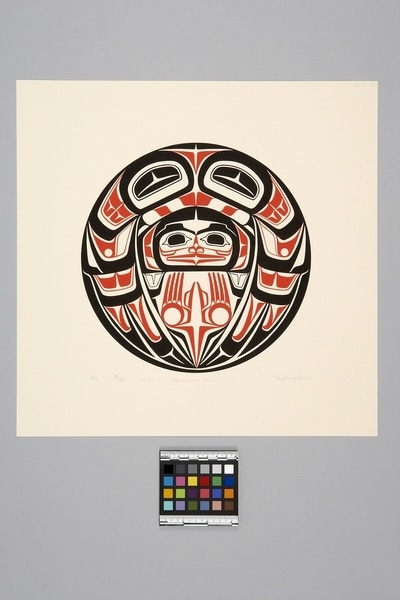Messenger Spirit Item Number: Nb7.288 from the MOA: University of British Columbia

Description
Circular, bilaterally symmetrical, red and black stylized image including a frontal face in a black ovoid at the centre. Bottom half of face is detailed in red with black ovoid eyes outlined bya tapering oval. Red hands below face with circular palms, four fingers, and with the thumbs to the centre. Outer edge of circle has a black ovoid with a split ovoid at the centre top on either side followed by a wing-like series of black u forms with various red details to the bottom centre. Pencil inscription across the bottom edge 'A/P IX/XX 10/1/77 MESSENGER SPIRIT Roy Henry Vickers'. The print is on a relatively square, light white-brown paper stock.
History Of Use
Northwest Coast serigraphs are a contemporary art form, deriving from early 20th century drawings of traditional crest and decorative designs, commissioned by anthropologists and undertaken by artists such as Charles Edenshaw. Residential schools reinforced the medium, while discouraging the use of traditional themes. An important series of traditional designs in coloured pencil and watercolour were done by Mungo Martin for UBC in 1949-50. The 1960's saw the rapid growth of prints, first in unlimited poster editions, and later with the establishment of the Gitanmaax School of Northwest Coast Indian Art at 'Ksan (1967), and of the Northwest Coast Indian Artists Guild (1977), limited edition art runs became the standard. Northwest Coast silkscreen prints are part of the mainstream art market, as well as functioning within the native context as potlatch gifts, and commemorative prints. Although there are distinctive regional styles, individual artists may work in several styles, or apply unique themes and variations to specific works.
Cultural Context
contemporary art
Item History
- Made by Roy Henry Vickers (Maker) in British Columbia, Canada on January 10, 1977
- Owned by Norman Sandomirsky and Tobie Sandomirsky before June 27, 1984
- Received from Norman Sandomirsky (Donor) and Tobie Sandomirsky (Donor) on June 27, 1984
What
- Name
- Messenger Spirit
- Identification Number
- Nb7.288
- Type of Item
- Manufacturing Technique
- silkscreened
- Overall
- height 37.6 cm, width 38.1 cm, depth 0.1 cm
Who
- Culture
- Tsimshian
- Creator
- Roy Henry Vickers (Maker)
- Previous Owner
- Norman Sandomirsky and Tobie Sandomirsky
- Received from
- Norman Sandomirsky (Donor) and Tobie Sandomirsky (Donor)
Where
- Holding Institution
- MOA: University of British Columbia
- Made in
- British Columbia, Canada
When
- Creation Date
- on January 10, 1977
- Ownership Date
- before June 27, 1984
- Acquisition Date
- on June 27, 1984
Other
- Item Classes
- works on paper
- Condition
- good
- Accession Number
- 0979/0002